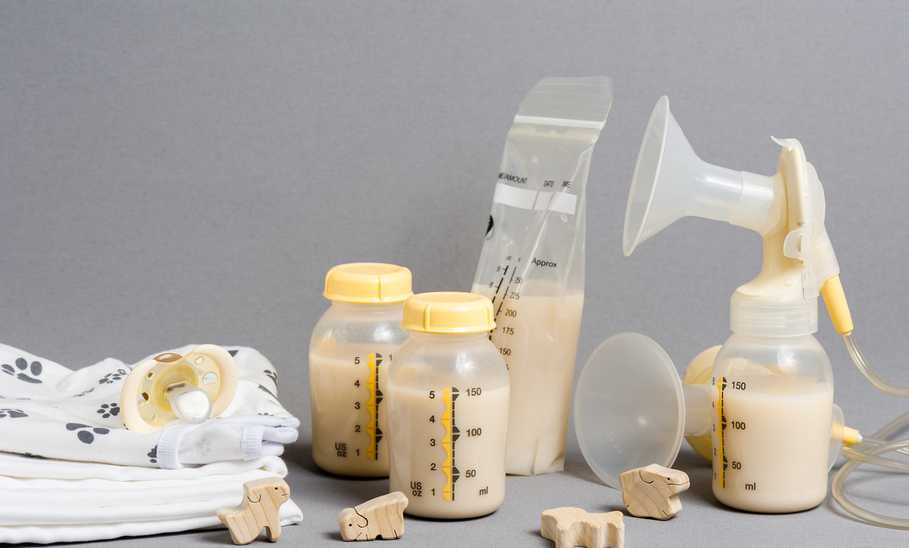I’ve breastfed and pumped for all three of my kids. Either of these is challenging enough on its own, but doing both at the same time seemed extra exhausting. What worked for one of my babies went out the window with the next one, and I felt as though I had to relearn it all over again.
Pumping brings its own set of difficulties, mentally, physically—you name it. From the mind games of whether you’re pumping enough milk to meet your baby’s needs to storage practices, there can be a lot of information to keep straight. I felt I was constantly researching and asking other moms about their experiences.
Luckily, with enough support, you can do both pumping and breastfeeding.
Is combining breastfeeding and pumping possible?
Combining breastfeeding and pumping is entirely possible, but it takes some knowledge and organization. It also takes a lot of work, even when your baby is nursing well. Not everyone needs or wants to do both, but it can help increase your milk production and give your baby the health benefits of breastmilk.
Reasons for combining breastfeeding and pumping
There are different reasons why you might want to combine breastfeeding and pumping, and you might be doing this for multiple reasons.
Increasing milk supply
“Most commonly, moms will do a combination of both pumping and nursing to help bolster milk supply or if there’s concern over an infant not getting enough,” explains Monica Wonnacott, MD, founder of Pediatric Answers.
If your baby is making enough wet diapers and gaining weight as they should, you can reassure yourself your baby is getting what they need.
Being away from your baby
“A mom will also pump to allow her to be gone from the infant for longer periods,” says Dr. Wonnacott. This can allow someone else, such as your partner, to feed your baby when you’re not there or to help with those middle-of-the-night feedings.
Going back to work
Dr. Wonnacott says that long-term breastfeeding and pumping are most commonly combined because many new mothers have to go back to work. For this, you don't need a freezer chest full of milk. Pumping every two to three hours is typical for many pumping parents while they’re away.
Overcoming challenges and common concerns
Low supply
In conversations with fellow moms who were nursing, the most common concern I heard was the worry about having a low milk supply. Your baby is much more efficient at nursing than the pump is at getting milk from your breasts. So it’s important to not look at the amount of milk you're pumping as a failure to make enough milk. If you’re concerned you may have a low milk supply, talk with a lactation consultant in order to get the best advice for your situation. It’s normal to get between a half ounce and two ounces of milk per pumping session.
Mental toll
Can we just acknowledge again how hard pumping and nursing are? If you’re concerned about your supply or your baby’s ability to nurse, it can really get in your head that you’re failing at this whole feeding thing. The mental health struggles with feeding your baby can seem relentless.
It’s important to consider yourself and acknowledge any challenging emotions you may have around breastfeeding and pumping. Having the right support can really help ease your worries about feeding your baby. Reach out to friends, family members, other mothers, and breastfeeding specialists, who may be able to offer comfort and advice during this stage.
Finding the time to pump
It’s recommended to nurse or pump eight to 12 times in a 24-hour period in the first six months. I’ve always been jealous of those who used wearable breast pumps because sometimes you just feel attached to a pump and can't get anything else done.
Best overall hands-free breast pump

Elvie Wearable Double Electric Breast Pump
Washing pump parts
There’s also the issue with finding the time to wash all those pump parts. The good news is, you don’t have to sterilize pump parts after every use, and in fact, sterilization isn’t needed to keep the parts safe to use. Just a good wash with dishwashing soap and warm water works.
Pros and cons of combining breastfeeding and pumping
Breastfeeding and pumping can be challenging, but there are positives to doing both.
Pros:
- Increasing your milk supply
- Having extra milk on hand for when you are separated from your baby
- Being able to practice having your baby get used to a bottle
- Relieving discomfort from engorged breasts
- Allows your partner to be more involved in feeding the baby
Cons:
- Oversupply problems, which can cause concerns such as blocked milk ducts or mastitis
- Sore nipples with more stimulation and suction
- More times you’re having to wash pump parts
Tips to maximize milk production
Here are some ways to get the most out of your pumping and nursing sessions.
An effective latch
Babies might instinctively know how to nurse, but that doesn’t mean they (and you!) won’t need some help. Talk with a lactation consultant to make sure your baby has the correct lip and tongue position when latching, so they’re able to transfer enough milk.
Pump correctly
You need to make sure you have the correct size of flange, which is the shield that covers your nipple and part of your breast. Too small or large, and they won’t be able to effectively help remove milk from your breasts.
If you’re going to be pumping a lot in the early days, you might want to consider renting a hospital-grade pump that is more powerful to get more milk.
Try galactagogues
Galactagogues are a substance you can take that can increase your milk supply. This could be an herb such as fenugreek, or even a prescription medication such as metoclopramide (Reglan). Most people don’t need to use these to increase their supply, but they can help. Before you take any supplements or medications, consult your doctor.
Storing and thawing breast milk
Milk storage and thawing guidelines can be confusing and do change over the years, so it’s important to get the latest information. According to the Centers for Disease Control and Prevention (CDC), here are the current best practices:
- Fresh pumped milk can sit out at room temperature (77 degrees or cooler) for up to four hours, up to four days in the refrigerator, or six to 12 months in a freezer.
- Thawed milk that’s been previously frozen can sit at room temperature for one to two hours and in the refrigerator for up to 24 hours. Never refreeze thawed breastmilk.
- Leftover breastmilk from a feeding can be used within two hours if your baby didn’t finish the bottle.
Since I was continuously sleep-deprived, I wrote these guidelines out and stuck them on the fridge, so I could keep it all straight.
Other tips for combining breastfeeding and pumping
Here are some other tips for combining breastfeeding and pumping:
- Work with an experienced lactation consultant or a La Leche League leader for breastfeeding and pumping advice for your own situation and concerns.
- Research has been back-and-forth on whether it’s safe to combine freshly pumped milk with cold milk. But there’s no research stating that combining warm and cold milk is unsafe, but if you want to be cautious, refrigerate pumped milk before combining it with cold milk.
- If you’re partnered, enlist their help by having them bring you the baby to nurse, or set up your pump parts. Have them help wash pumping supplies and bring you water and snacks.
Supportive resources for breastfeeding
I’ve breastfed a combined seven years (and counting) and there are several breastfeeding resources I find myself continuously coming back to.
La Leche League International
The La Leche League (LLL) website is full of resources from everything on medications you can take while breastfeeding to how often you should pump when breastfeeding. I referred to it constantly. They even have local virtual and in-person support groups.
KellyMom
KellyMom’s website was also introduced to me when my first baby was born and it’s another reliable source of information on breastfeeding and pumping advice. It gives evidenced-based information on concerns such as plugged milk ducts, milk storage guidelines, and advice for pumping parents in the workplace.
Breastfeeding support groups
My LLL support group was the most valuable resource I had when I was a new nursing mom. I attended weekly to get my questions answered, connect with other parents, and have a safe place to get the hang of nursing without judgment.
Facebook also has a lot of supportive groups for breastfeeding whether you nurse, pump, or do both. BreastfeedingUSA.org has support groups. You can also search hospital-based or community-based groups in your area. It’s always good to be cautious of advice over the internet, though. Make sure you’re getting your advice from a reliable source such as a LLL leader or certified lactation consultant who might be leading your group. Not every support group might have a certified leader.
Certified lactation consultant
The highest accredited healthcare professional who specializes in breastfeeding support is called an IBCLC, which stands for International Board Certified Lactation Consultant. IBCLCs are certified by the International Board of Lactation Consultant Examiners and are frequently healthcare professionals such as nurses and doctors. Certified Lactation Counselors (CLC) have less certification and training and can help with simpler breastfeeding concerns.
You can find a lactation consultant in private practice or ones that are associated with hospitals and clinics. IBCLCs, with their advanced training and skillset might be a good option, but they may be harder to access in more rural areas.
Frequently asked questions (FAQs)
What is power pumping?
Power pumping can help increase your milk supply by mimicking your baby’s cluster feeding. This means you’re pumping in shorter segments and more often within a set time period. There’s no set rule for power pumping, but this might look like pumping in a 20 minute session, resting for 10 minutes, pumping for 10 minutes, then another 10 minute rest before pumping again for 10 minutes.
How to determine the right frequency and duration of pumping sessions
According to Dr. Wonnacott, how often you pump depends on your goals. If you’re going back to work and want to maintain breastfeeding, Dr. Wonnacott recommends pumping as often as your baby would eat. This could be every two to four hours. “Pump for two to three minutes beyond dry in order to get any remaining hindmilk,” says Dr. Wonnacott. Hindmilk is the milk that comes toward the end of a pumping or nursing session that contains more fat.
How long should you wait after breastfeeding before pumping?
“It’s ideal to pump shortly after breastfeeding, within 30 minutes,” says Dr. Wonnacott. This allows your body enough time to make more milk for your baby’s next feeding.
How to increase milk supply through pumping after breastfeeding
La Leche League says you don’t need to pump after set intervals, but to pump as often as you’re able. Shorter pumping sessions are usually better than longer ones. Even just a few minutes of pumping can help stimulate your milk supply.
Many people tend to get the most milk at certain times of the day, such as at night or early in the morning. Try to pump during these times after breastfeeding.






